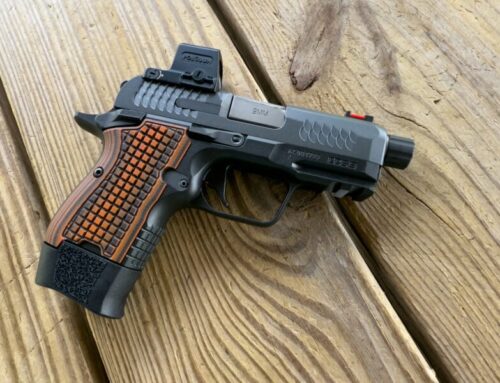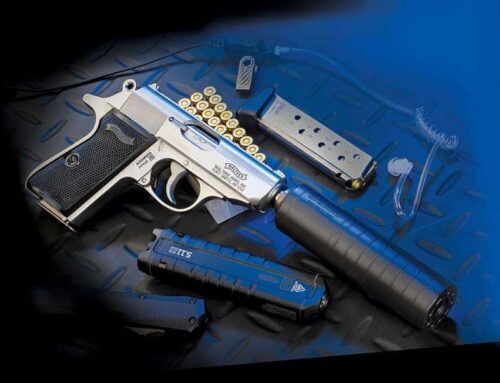Have you ever shown someone how to shoot a handgun for the very first time?
If so, how did you explain the proper relationship between front and rear sights? Did you use the two fingers on one hand and single finger on the other to illustrate the concept? One of those drawings you see on the wall of shooting range classrooms? Or perhaps a custom Lego structure?
While second nature to experienced shooters, standard notch rear sights are a little tough to explain to someone who’s never handled a gun.
“Hold the gun so the front sight is exactly centered in the notch of the rear sight. Good. Now make sure the top of the front sight is exactly level with the top of the rear sight. OK, now turn back around and face the target. Yes, but now the front sight is not centered sideways anymore. OK good. Now make sure all that lines up with the target. Say what?”
Battle rifles like the M1 Garand, Springfield Armory 1903 A1s, M1 Carbines, M14s, M16s and many more use an aperture sight system. So do long-range iron sighted competition rifles. And those World War II ship-mounted anti-aircraft guns.
Why?
Mainly because aperture sights work half-automatically. When you look at a post or dot on the front through a ring in the back, your brain kicks in to mega-OCD mode and wants to automatically center the front sight in the aperture circle. It’s a biological process called “magic.” It means you don’t really have to think about anything. Look through the hole at your front sight and place it over the target. The rest is auto-magical. Your brain subconsciously makes sure that the front sight is in the center of the rear sight circle.

Note the flat front edge. This allows one-handed slide racking on a belt or table if things really go south.
While I’ve shot lots of rifles with aperture sights, I’ve never shot a pistol with aperture sights. Until now.
I mounted a RAPS (Rear Aperture Front Sight) on a Glock 17 Gen 4 to test it out.The RAPS is a new offering available through White Raven Communications and it sells for about $30.
So how did it shoot?
The RAPS configuration is fast. Scary fast. There is no conscious process of sight alignment. Bring your gun up, look for the front sight and the rest is automatic. One of the unexpected benefits, and reason for the speed, is that there is nothing on which to focus on the rear sight. It’s just a big hole. You simply can’t help but to immediately focus on the front sight and front sight only. With standard rear sights, you may think that both front and rear sights are in focus, but they’re not. That’s just your brain rapidly switching focal points between the front and rear.
I had no problem with precision using the RAPS. My outdoor range is chock full of fun, and small, targets like golf balls, tennis balls and spent shotgun shells. I was easily able to hit any target I’m capable of hitting with any other type of sight. The large rear aperture may look imprecise, but it’s not. Your brain deals with it. In short, the sight didn’t limit my shooting accuracy.

The rear sight unit is slightly higher than a standard Glock sight.
One other thing to note. The forward edge of the RAPS is milled flat. So, in a pinch, you can hook this on to a belt or holster and rack the slide one-handed should you need to.
The manufacturer states that the RAPS sight “This sight should not be used for competitive shooting where finite accuracy is required.” I think that statement needs a big qualifier. If you’re shooting bullseye pistol events where you care about 1/10 of an inch at 50 yards, maybe. If you shoot the “speed” pistol sports like Steel Challenge, IDPA or USPSA, I completely disagree. All of those events have targets inside of 25 yards and I find the RAPS sight noticeably faster to acquire than standard sights. I’m not a bullseye target shooter, but I had no problem hitting golf ball size targets at 25 yards with the RAPS.
Installation is easy once you get the Glock factory rear sight off. If you have a sight pusher tool, or know someone who does, like most any gun store, cool – use that method. If not, you can use a brass punch to drive the factory sight out. Be careful, it’s tight in there. Once you get the Glock rear sight removed, the RAPS will slide right into place. Center it and tighten it to the frame using the small allen screw that is just forward of the aperture ring. If you need to adjust, loosen, move and re-tighten. Piece of cake.
This is a nifty upgrade. Given the price, and that it’s easy to reinstall the factory sight, give it a try. I got spoiled by the speed of these sights and intend to leave it on my Glock 17.







Sold! Great review…I’m going to order one for my 17. Thanks!
Sounds good are they making them for S&W M & P ?
Not yet – just Glocks. I would guess the maker would expand offerings at some point based on demand.
Thanks Tom keep up the great work. Good reading and some laughs
Thanks! We’ll keep trying on this end!
Do they make one for the Glock-20?
Hey Don – They fit on all Glock models. Rumors are that Springfield Armory XDs and Smith & Wesson M&Ps are in development.
What about in the dark for home defense? Could there be another model with a glow-in-the-dark ring around the rear aperture?
Great minds think alike! That’s next on the agenda, I am mounting a single night sight on the front of the Glock 17 in this article to work with the RAPS and a night sight to see how that works in low light conditions. Will report on the results in the coming weeks.
Awesome. I can see this rear aperture being perfect for day light situations but if you already have something like a Trijicon front sight, losing the Trijicon rear sight may hinder accuracy. However, this is perfect for upgrading the standard, stock, Glock sights!
Ghost ring sights of this type are not Notch and post design. Thus are not legal in IDPA.
Didn’t ameriglo make a ghostring night sight already?